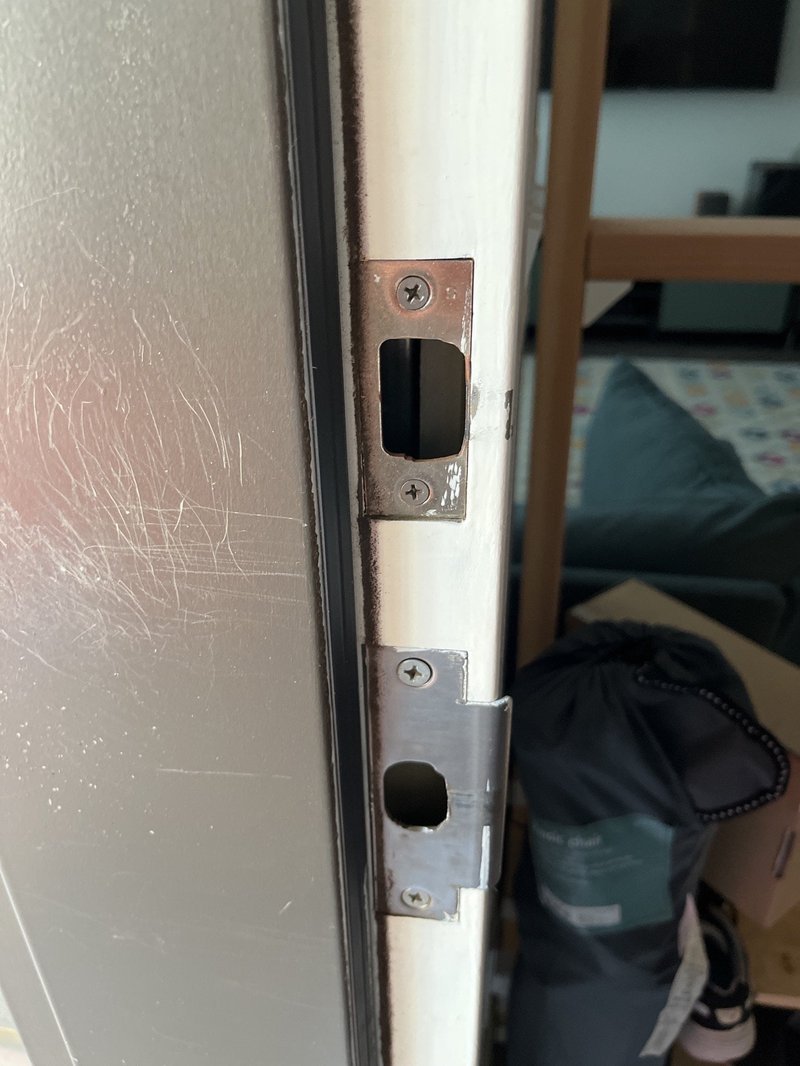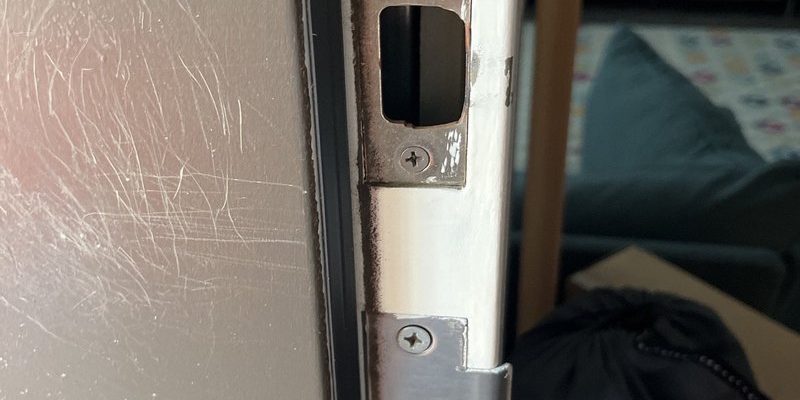
This happens across brands and types, whether you’re using a classic Kwikset or Schlage manual lock, or even a smart deadbolt that pairs with a remote or app. The brand might change, but the issue stays the same: the bolt isn’t sliding far enough into the strike plate on the door frame. The culprit? More often than not, it’s all about the strike plate depth—or, to put it plainly, how much space your door frame gives for that metal bolt to tuck into. Let’s break down why this happens, what it means for your security, and how to fix it—no locksmith degree required.
What Does It Mean If a Deadbolt Only Engages Partially?
When a deadbolt only partially engages, it means the bolt doesn’t fully extend into the hole in the door frame that the strike plate covers. So, instead of the solid “thunk” you expect, you might get a softer click, or sometimes the key just comes to a stop halfway.
Honestly, it’s a bit like trying to plug your phone into a charger, but the port is just a hair too small—the connection is halfway there, but it’s not secure. For a lock, this is a big deal. *Partial engagement* leaves your door easier to jiggle open, or even side-slam if someone was determined enough. And if you’re using a remote deadbolt (like a Yale or August smart lock), you might even see the bolt try to retract or extend, fail, and beep or flash a code to warn you.
Let me explain why this matters: a fully engaged deadbolt is what gives your door its real security. If it’s not deep inside the frame, anyone with a little force—or even a credit card—might defeat it. Whether you lock up every time you leave or just want peace of mind at night, making sure the bolt fully extends is crucial.
Why Strike Plate Depth Makes All the Difference
The *strike plate* is that metal rectangle you see on the edge of the door frame where the bolt slides in. Behind it, there should be a hole—deep enough for the entire bolt to fit. If this hole (or “mortise pocket” if you want to sound fancy) is too shallow, your deadbolt can’t fully extend.
Here’s the thing: door frames aren’t always perfect. Maybe the carpenter drilled the hole a bit too small, or maybe the wood swelled with humidity. Even something as simple as a shifted hinge can slightly move where the bolt lines up with the plate. Common deadbolt problems from strike plate depth issues include:
- The bolt only goes in halfway, preventing the lock from fully engaging.
- The remote lock tries to engage but gets stuck or sends a pairing error (especially with smart models).
- Difficulty turning the key—you feel like you’re forcing it, because the bolt is hitting the back of the shallow hole.
If you’re troubleshooting a brand like Schlage, Kwikset, or any smart lock, the root cause can still come down to this simple depth issue. Even after you replace batteries, reset the code, or try to sync it with a new app—if the bolt isn’t going in far enough, you’ll keep running into problems.
Signs Your Strike Plate Is Too Shallow
You might be wondering: how can you tell if the strike plate depth is the real issue? Good question. There are a few classic symptoms, and you don’t need fancy tools to spot them:
- Deadbolt stops halfway: When you try to lock it, the bolt only goes partway into the frame and stops, sometimes with a “thunk” or a stubborn resistance.
- Key won’t turn smoothly: You find yourself jiggling or pushing harder than usual when locking or unlocking. It should be smooth—friction means something’s blocking the bolt.
- Lock acts differently in warm or cold weather: Wood swells or shrinks with humidity, making a tight strike plate even tighter in summer.
- Remote lock errors: If you use a remote smart deadbolt, it might beep, flash, or even refuse to pair, thinking the lock is jammed or out of alignment when the real issue is just a shallow strike plate.
*One quick check*: Open the door and try locking the deadbolt. If it slides out smoothly every time, but jams only when the door is closed, the strike plate depth or alignment is *almost always* your culprit.
How to Check Your Strike Plate Depth
If you think this might be your issue, don’t worry—it’s easy to check right at home. Here’s how I’d walk a friend through it:
- Open the door and look at the hole behind the strike plate. Is it deep enough for the *entire* deadbolt to fit when extended?
- Try manually throwing the deadbolt with the door open. If it moves freely, but gets stuck with the door closed, focus on the strike plate area.
- Remove the strike plate (usually just two screws) and measure the depth of the mortise pocket behind it. Standard deadbolts need about 1 inch (25mm) of depth. If it’s less, you’ve found your issue.
- Check for wood chips, paint build-up, or anything else that can block the bolt from going all the way in.
For anyone using a smart lock, like a Yale or Schlage model with a remote, try locking and unlocking using both the manual key and the app/remote. If you get stuck both ways (but only when the door is closed), your strike plate isn’t deep enough.
If the deadbolt “floats” in and out easily with the door open but sticks or can’t fully extend when the door’s closed, the strike plate or the hole behind it is almost always to blame.
Fixing a Deadbolt That Only Engages Partially
Once you’ve identified the problem, fixing it is pretty straightforward. Here are the basic steps, whether you’re a DIY novice or just nervous about messing with your door:
- Remove the strike plate: Use a screwdriver to take off the plate and set it aside.
- Deepen the pocket: Grab a chisel or a large drill bit (about 1 inch) to carefully make the mortise pocket deeper. Go slow—a little at a time. You want enough space for the bolt to slide in fully, but not so deep you punch through the door frame.
- Clean out debris: Clear away any wood chips, splinters, or paint that might block the bolt.
- Test and reinstall: With the plate off, test the deadbolt’s extension. Once it fits easily, reattach the strike plate and try again with the door fully closed.
If you have a remote or smart deadbolt, make sure to test both manual and remote/paired functions before calling it done. Sometimes you’ll need to reset or sync your lock after fixing the strike plate—especially if it got confused by previous jams or battery issues.
What If the Strike Plate Isn’t the Only Problem?
While strike plate depth is the top reason for partial engagement, there can be other causes. Sometimes, it’s a door alignment issue—the door sags, or the hinges are loose, making the bolt hit the wrong part of the strike plate. Other times, the bolt itself is bent, or there’s debris inside the mechanism.
Here’s how to tell:
- Misalignment: The bolt hits the edge of the strike plate rather than the hole. Try lifting the door gently as you lock—if it works, your door may need realignment or new hinge screws.
- Faulty bolt: An old, bent, or jammed bolt can get stuck even with a perfect strike plate. You’ll notice roughness or sticking even with the door open—if so, it’s time to replace the deadbolt hardware.
- Inside debris: Older locks can get full of gunk or sawdust. Spray a little lubricant or clean carefully with a toothpick, then try again.
For smart locks or remotes, low batteries or pairing issues can make the mechanism weak or inconsistent. If you’ve checked the strike plate and everything lines up, try a fresh battery and run a reset or re-sync to troubleshoot.
When to Call a Locksmith (and When You Don’t Have To)
Let me be honest: most strike plate depth issues don’t need a professional. Basic tools, a little patience, and maybe a YouTube video can get you sorted in under an hour. But there are times when it makes sense to get help.
If you find:
- The door frame is cracked or warped, making DIY fixes tough.
- You drilled out the pocket, but the bolt *still* won’t fully engage.
- Your smart lock keeps flashing error codes, even after checking the manual, replacing the battery, or resetting the code.
- You’re worried about damaging your doors or voiding a warranty (some smart locks, like August and Yale, can be picky about DIY repairs).
That’s when it’s smart to call in a pro. They’ll check not just the strike plate but the whole system: alignment, smart lock code, sync, battery, and more.
Deadbolt Types, Brands, and the Strike Plate Factor
All deadbolts, whether you prefer a simple manual lock or a fancy remote smart lock, rely on that one crucial detail: the bolt has to fit into the frame.
Brands like Schlage, Kwikset, and Yale all use roughly the same basic deadbolt design, though some smart models add extra length or motorized mechanisms. Universal deadbolts might give a little more tolerance, while brand-specific ones can be sensitive to small depth mistakes. Even if you upgrade to a newer smart deadbolt that pairs with an app or remote, the *mechanical* part of the bolt must fit the strike plate pocket.
It doesn’t matter if you have the fanciest key code system on the block—if the bolt can’t extend fully, your door isn’t truly locked.
If you do swap brands or upgrade to a new smart lock, always double-check the strike plate depth before installing. Many “universal fit” deadbolts require you to enlarge or tweak the hole, no matter what the box says.
Keeping Your Deadbolt Smooth (and Secure) in the Long Run
Once you’ve fixed the strike plate depth, a little ongoing care goes a long way. Regularly check your deadbolt’s movement—if it starts feeling sticky, don’t ignore it. Lubricate the mechanism every few months (use graphite for manual locks, or follow your smart lock brand’s manual for approved lubricants).
Here’s a tip: after any heavy rain, snow, or humidity spike, double-check your deadbolt. Wood doors and frames can swell and shrink with the weather, making a previously perfect fit suddenly too tight. For remote or battery-powered deadbolts, always keep spare batteries handy. If your lock starts throwing codes, refusing to sync, or acting up, check both the electrical and mechanical sides.
With a little attention, you can keep your deadbolt fully engaging for years—no more halfway locks, no more security worries.
Wrapping Up: Why Strike Plate Depth Is the Hidden Key to a Properly Engaged Deadbolt
A deadbolt that only engages partially isn’t just a minor annoyance—it’s a real security risk. Most of the time, the problem boils down to the depth of the strike plate pocket in your door frame. It’s easy to check, usually simple to fix, and makes all the difference whether you use a classic manual lock or a high-tech remote smart lock.
If you’re ever in doubt, start with the basics: strike plate depth, door alignment, and clean, smooth hardware. From there, most deadbolt issues fall right into place. And remember—peace of mind should always “click” into place, every single time you lock your door.
